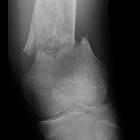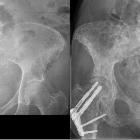pathological fracture





































Pathological fractures are fractures that occur in abnormal bone and occur spontaneously or following minor trauma that would not otherwise fracture biomechanically normal bone.
Terminology
The term pathological fracture is usually reserved for malignancies, either benign or malignant, although it has been used in the setting of osteomyelitis. It can be used in the setting of generalized metabolic bone disease (e.g. Paget disease, osteopetrosis), although the term insufficiency fracture is probably more correct . Insufficiency fractures are fractures due to multiple minor events causing a cumulative load on weakened osteoporotic bone. Fragility fractures on the other hand, are acute fractures in osteoporotic patients due to a single event of minimal trauma.
Pathology
Location
The most common location for pathological fractures are :
- subtrochanteric femur
- humeral head and metaphyseal junction
- vertebral body
In addition, in adults patients, the avulsion of the femoral lesser trochanter should be considered a pathological fracture until proven otherwise .
Treatment and prognosis
Pathological fractures are feared by oncologists because they may cause immobilization of their patients, especially when the spine or lower extremities are affected.
Practical points
A radiologist should mention the possibility of a pathological fracture if an osteolytic metastasis is seen. In principle, every osteolytic focus in the femoral neck or the spine is at risk of a pathological fracture.
Scoring systems have been developed to assess the fracture risk of bone metastases, the Mirels classification is the one that has gained the most traction, although its poor sensitivity (35%) means that it is not without its controversy .
Siehe auch:
- Knochenmetastasen Mammakarzinom
- Knochenmetastase Prostatakarzinom
- pathologische Femurfrakturen
- Knochenmetastasen Nierenzellkarzinom
- Wirbelkörperfraktur vs. Wirbelkörpermetastase
- Frakturrisiko bei Knochenmetastasen
- pathologische Wirbelkörperfrakturen
und weiter:
- fissurale Fraktur
- Stressfraktur
- Frakturformen
- pathologische Fraktur bei Enchondrom
- Insuffizienzfraktur
- maligne Osteolysen
- Fraktur
- pathologische Fraktur Humerus
- intraossäres Hämangiom
- fractures of the extremities - general rules and nomenclature
- Knochenmetastasen
- Marschfraktur
- pathologische Fraktur bei juveniler Knochenzyste
- Ermüdungsbruch
- Morbus Paget des Femurs mit pathologischer Fraktur
- osteosarcoma with pathological fracture
- Mirel's score
- unicameral bone cyst with a fracture
- unicameral bone cyst with fracture
- Skeletaler Lymphombefall

 Assoziationen und Differentialdiagnosen zu pathologische Fraktur:
Assoziationen und Differentialdiagnosen zu pathologische Fraktur:

